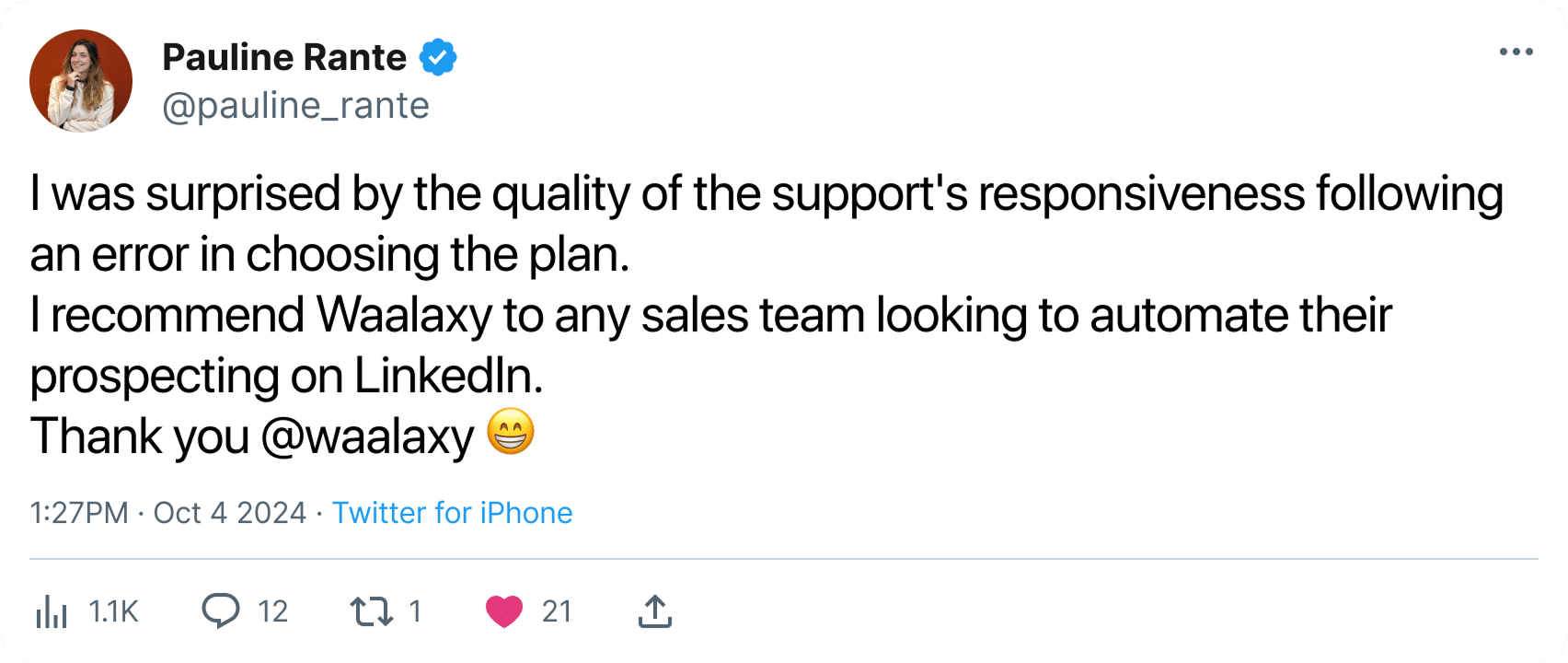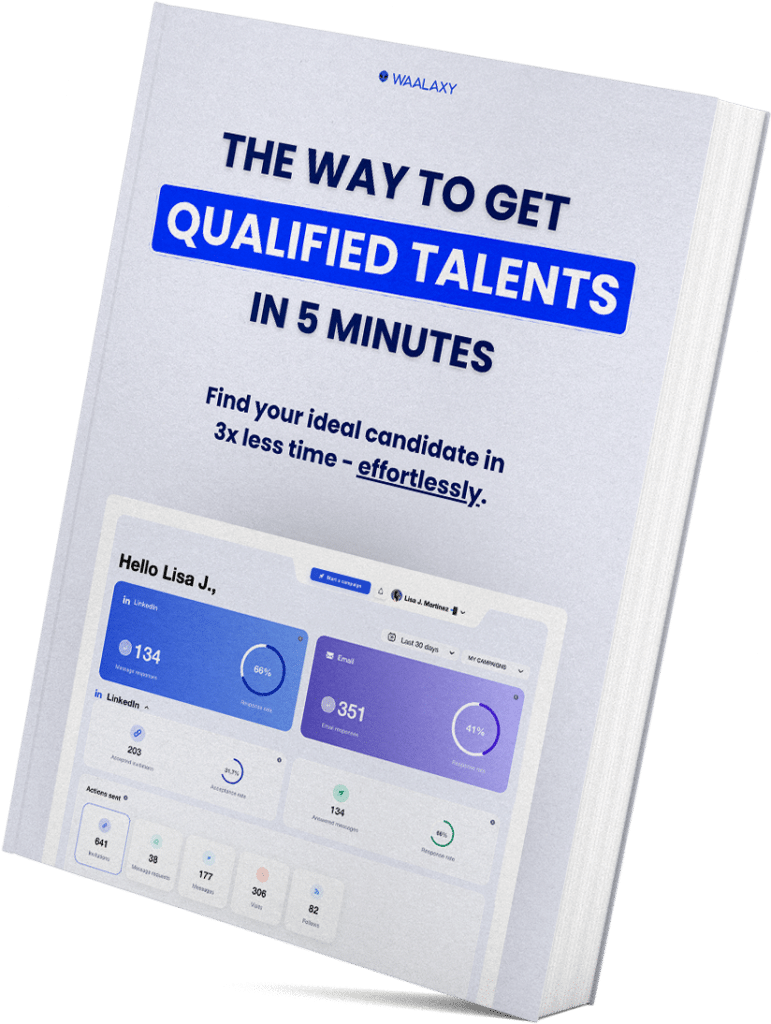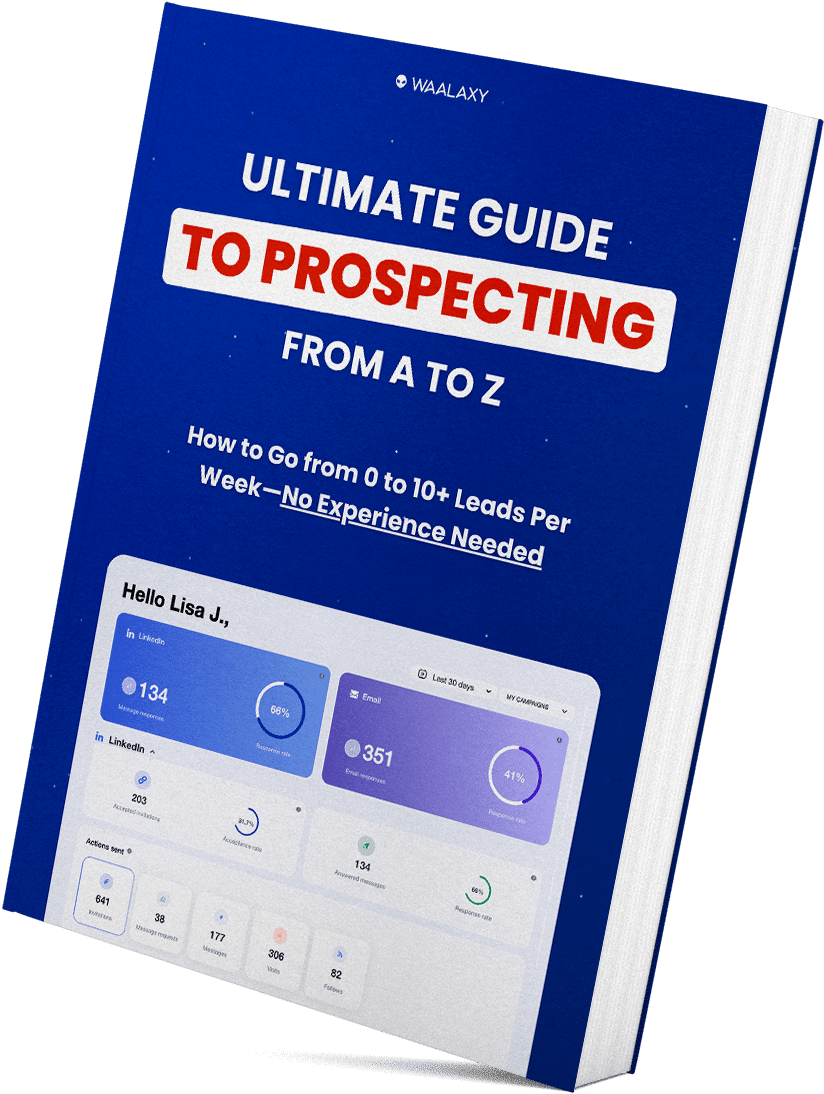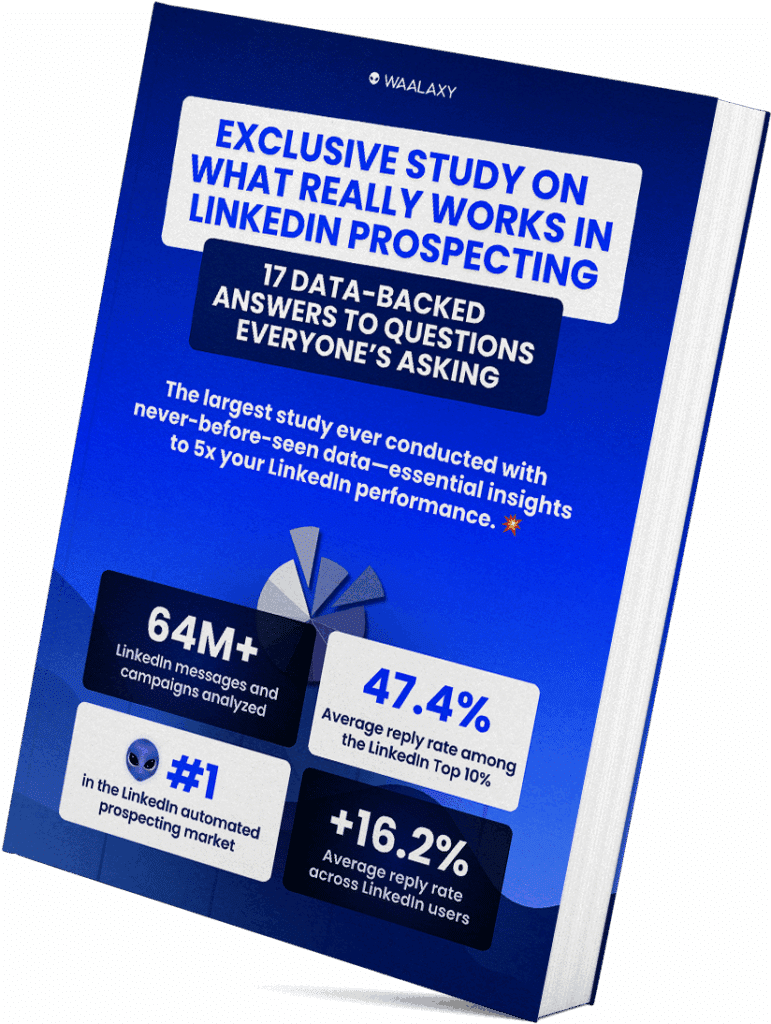Having a good product or service isn’t enough to sell effectively. What really makes the difference is how you lead your prospects to purchase. That’s where the sales cycle comes in: a structured process that enables you to optimize every interaction with your future customers, from prospecting through to retention.😎
The problem? A poorly structured sales cycle can create stumbling blocks: lost leads, abandonment along the way, low conversion… sales that go right out the window! 🥲
So, how do you make selling easier? Here’s how. 👀
What is the sales cycle?
The sales cycle is simply the path a prospect takes before becoming a customer. It consists of 7 key stages:
- Prospecting.
- First contact.
- Prospect qualification.
- Presentation of your solution.
- Sales proposal.
- Closing the sale.
- Follow-up.
The objective? Guide the prospect through the buying process, reducing blockages and maximizing the chances of conversion. The clearer and more efficient your sales cycle, the easier it is for your customers to make the right decision.🎯
Why is the sales cycle a key lever for your business?
A well-structured sales cycle enables you to sell more, faster and more efficiently. It helps to :
- ✅ Better qualify prospects to avoid wasting time with those who aren’t interested.
- ✅ Reduce the time between making contact and closing the sale.
- ✅ Optimize every interaction with the prospect to increase your chances of conversion.
But, what if your sales cycle isn’t well-defined or has flaws? 🤔
If your sales process isn’t fluid, you’re losing opportunities at every stage:
- ❌ Losing prospects along the way: A lack of follow-up or a poorly targeted first contact can scare away interesting leads.
- ❌ Too much friction in the customer journey: A complicated customer experience, delayed responses or poorly managed objections put the brakes on conversion.
- ❌ Lost sales opportunities: If you don’t follow up effectively or if your offer lacks clarity, your prospect moves on to the competition.
You’ve got it: an effective sales cycle is the key to maximizing your conversions! In what follows, we explain how to optimize it to sell more and better. 🚀
The 7 stages of the sales cycle: Best practices
A well-structured sales cycle enables you to convert more prospects into customers while optimizing your time and resources. Here’s a detailed guide to understanding and optimizing every step of the process 😎
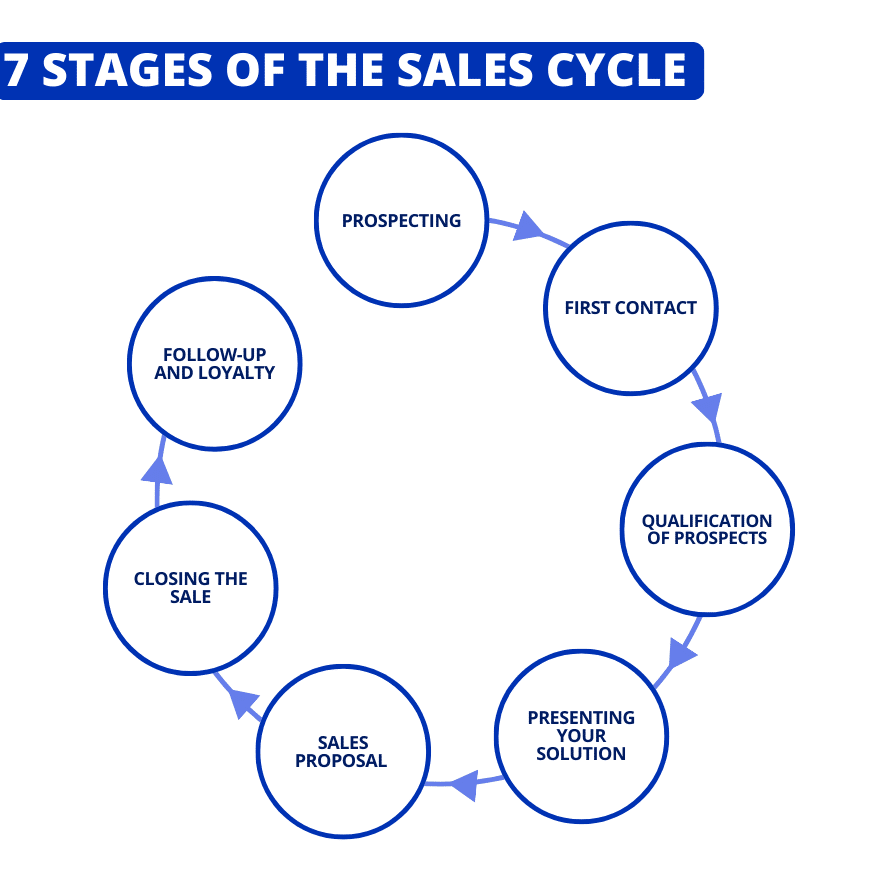
1. Prospecting: Finding and attracting the right prospects
Prospecting is the first step in the sales cycle, and one of the most critical. Without effective prospecting, you’re wasting time contacting people who aren’t really interested 🫠
How do you define your ideal prospect?
Before looking for prospects, it’s essential to know who you’re talking to. To do this, you need to create a buyer persona, i.e. a detailed representation of your ideal customer.
✅ Criteria to consider when defining your persona :
- Professional data: industry sector, company size, position held.
- Problems and needs: what are the main challenges they face?
- Preferred channels: how does he get his information? LinkedIn, email, events, word-of-mouth?
➡️ But which tools do you use? Delve.ai or ChatGPT can help you create your target base.
Here’s an example prompt 👇🏻:
“Create me a detailed B2B persona for an [industry] that targets [type of customer]. The persona should include:
– Name and position
– Industry and company size
– Professional goals and challenges
– Problems encountered in daily life
– Pre-purchase decision criteria
– Preferred information channels (LinkedIn, emails, webinars, etc.)
The tone should be clear, accessible, and synthetic. Present it in the form of a simple, quick-to-read fact sheet. You can ask me questions if you need more information.”
What channels should I use to prospect effectively?
1️⃣ LinkedIn: Ideal B2B platform for contacting decision-makers.
2️⃣ Emailing: Reach a wider audience with a good conversion rate (between 2% and 5%).
3️⃣ Cold calling: Useful for quickly qualifying a prospect and getting an appointment.
4️⃣ Social networks and content: Social selling via LinkedIn or X can be very effective.
2. First contact: Engaging in conversation and capturing attention
That’s it, you’ve identified your prospects. Now you have to make them want to talk to you. This is a key moment: a well-turned message can open the door to future collaboration, whereas a message that’s too cold or generic risks ending… in total indifference.🥶
So how do you capture attention from the very first words?
Imagine running into someone at a business event. You don’t jump up and shout, “Buy my product!” do you? You strike up a conversation, show that you’re interested, and little by little, the discussion evolves. On LinkedIn, by email or on the phone, it’s all the same. ✨
The objective of the first message is to break the ice and open an exchange, not to close a sale immediately :
- ✅ Your prospect needs to feel that you’ve taken the time to take an interest in them.
- ✅ Your message should be short and to the point.
- ✅ And above all: it must show value, what you’re going to be able to bring to your future customer.
➡️ Here’s an example:
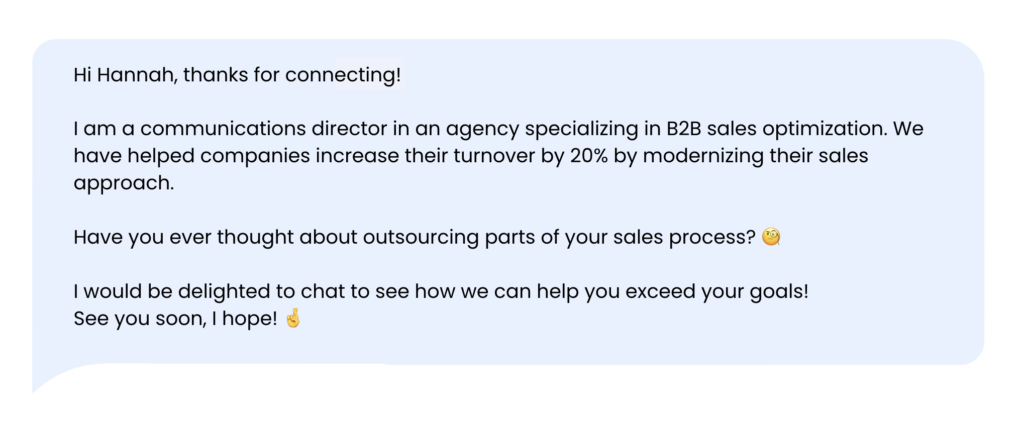
Why does it work?
➡️ Proposed solution: We show how your solution can help them.
➡️ Problem identified: A common pain point is mentioned.
➡️ “Natural” call to action: No obligation, just an invitation.
3. Qualification: Identify high-potential prospects
Okay, you’ve started talking to your prospects. Now it’s time to separate those with real buying potential from those who aren’t ready (yet). Because let’s be honest: not everyone is going to become a customer. 🥲
What’s a qualified lead?
A warm lead is a contact who 👇🏻 :
- 😣 Has a real need: He’s actively looking for a solution.
- 💰 Has the means : Has the budget to buy your offer.
- 🤓 Is involved in the decision: He’s a decision-maker or influencer in his company.
- 🏃🏻♀️ Is ready to take action: He has a concrete deadline in mind for his purchase.
One of the best ways to sort this out is to ask the right questions. From your very first exchanges, try to understand where your interlocutor stands. 👀
The BANT method is a good starting point. It allows you to evaluate four essential criteria:
- 💸 Budget: “Have you already allocated a budget for this project?” If the answer is unclear or negative, you may need to convince upstream or revise your targeting.
- 👩🏻⚖️ Authority: “Are you the person who makes the final decision on this type of investment?” If your contact has yet to talk to his boss or the purchasing department, you’ll need to adjust your approach.
- 🥹 Need: “What are the main difficulties you’re facing today?” Here, the aim is to validate that your solution does indeed address a concrete, urgent problem.
- ⏳ Timing: “When do you want to implement a solution?” A prospect ready to buy quickly deserves more attention than one who puts everything off until next year.
If your prospect clearly meets these criteria, he’s a hot lead! He has a problem, a willingness to buy and the power to decide. If one or more points remain unclear, you may need to nurture the relationship by accompanying him until he’s ready. 🤗
How can you automate the qualification of your leads?
Qualifying a lead can be time-consuming, especially if you have a lot of contacts to process. That’s where tools like Waalaxy come in. Thanks to automated scenarios, you can also send messages. The tool analyzes responses for you, and pinpoints the prospects most committed to helping you. 👇🏻
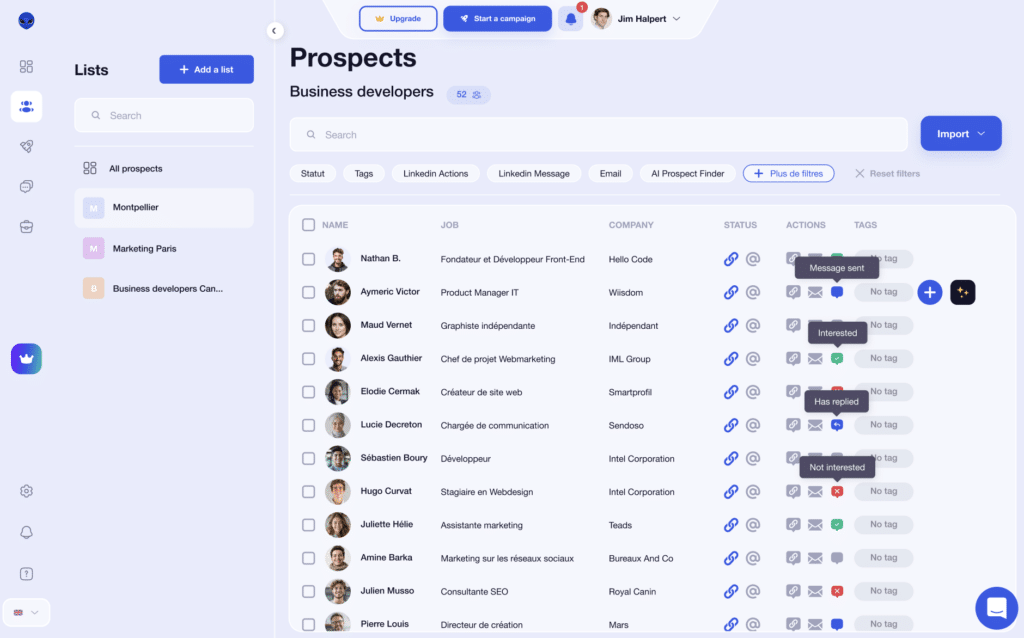
The idea is to naturally filter out hot prospects and focus on those with real potential. And what about the others? You leave them in a nurturing tunnel so that they contact you again at the right time.☎️
4. Presentation: Showcasing your solution
You’ve found your prospect, he’s responded to you, and you’ve validated that he’s genuinely interested. Now it’s time to present your solution. But don’t just list all the features of your product or service. What really counts is showing him how you’re going to solve his problem 🎯
The secret of an effective presentation is to start from the “pain point”, i.e. the problem your prospect is facing. If you can show him that you understand his difficulty and that you have the ideal solution to help him, he’ll be much more receptive. 👀
How do you organize your presentation?
A good sales pitch follows a three-step logic:
- 1️⃣ Recall the prospect’s problem to show that you understand their situation.
- 2️⃣ Present your solution as the obvious answer to the problem.
- 3️⃣ Illustrate with concrete evidence.
Let’s take an example: you sell lead management software for sales reps. Rather than saying 👇🏻 :
❌ “Our tool allows you to automate your prospecting and manage your leads.”
➡️ Try instead:
✅ “Today, your sales reps spend hours searching for contacts and manually re-contacting prospects. The result: wasted time, forgotten prospects, missed opportunities. With our tool, you automate all that and focus your energy on conversion, which on average increases your ROI by 30%.”
See the difference? We first talk about the problem before presenting the solution, and above all, we add proof to make it all credible.🤓
But how do you choose your arguments? Here are 3 questions your prospect is asking and you need to answer 👇🏻 :
- Does it solve my problem?
- Is it simple and effective?
- Why you rather than someone else?
Not all prospects are sensitive to the same arguments. Some want to save time, others are looking for a quick return on investment, and still others need reassurance.
Ask a key question before presenting your solution:
“If you had to improve just one aspect of your current process, what would it be?”
His answer will give you an ultra-relevant angle of attack from which to tailor your pitch.🗣️
Words are good. But proof is even better. He needs to see that it works for others before he commits. For that, you can share 👇🏻 :
- 🔢 Figures.
- 💬 Customer testimonials.
- 👩🏻💻 Demonstrations.
5. Sales proposal: Building an irresistible offer
You’ve captured your prospect’s attention, he’s understood that your solution can bring him value, and he seems interested. Now it’s time to make your proposal clear, convincing and irresistible (grrr 🦁).
Before we look at how to structure an effective offer, let’s talk about the classic pitfalls that can ruin your chances of conversion 🥲 :
- ❌ Too much information at once : A prospect doesn’t want to read a novel. Get to the point.
- ❌ No personalization: A generic offer gives the impression of being just a number on a list.
- ❌ No clear call to action: If you don’t say what you want him to do, he’s likely to do nothing.
- ❌ A price without context: If you announce a price without explaining the value it brings, the prospect may find it too expensive.
A good sales proposal should be short, clear, and actionable. Here’s the ideal structure to follow:
- 1️⃣ Summary of the prospect’s problem.
- 2️⃣ Quick presentation of the solution.
- 3️⃣ Value and concrete benefits.
- 4️⃣ A CTA.
Here’s a small example 👇🏻 :
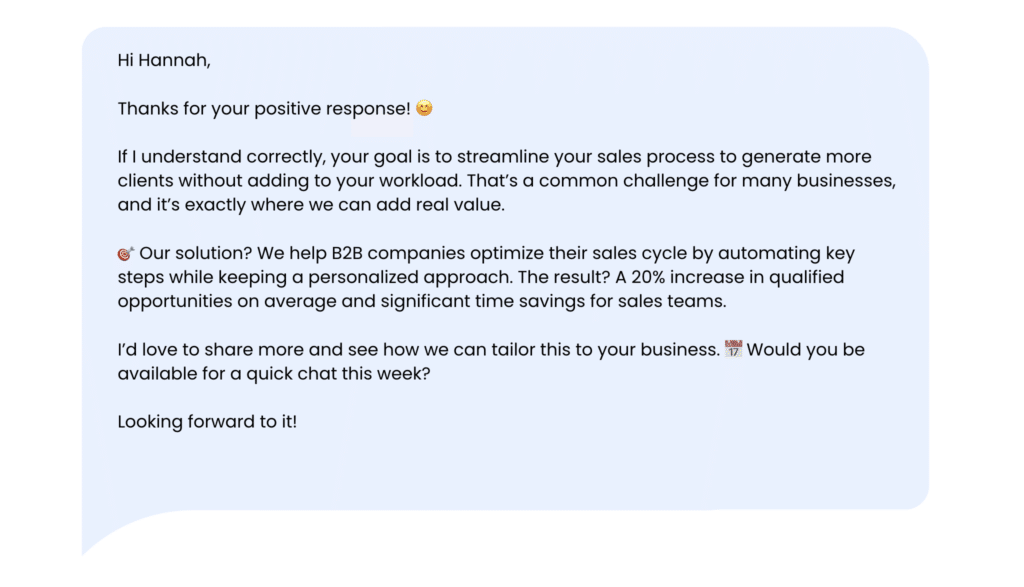
A good Call-To-Action (CTA) should be simple, clear, and above all immediately actionable. Here are a few examples:
If your objective is a discovery, call:
➡️ “Available this week to discuss?”
➡️ “Here’s my calendar, choose a time slot that suits you: [Calendly link]”
If you want him to test your solution:
➡️ “Try it for free for 7 days: [Sign up link]”
➡️ “Would you like me to send you a test access?”
If you want quick feedback:
➡️ “Is this what you’re looking for?”
➡️ “Let me know what you think, I’m available if needed.”
A good CTA should remove any doubts and make the next step easier. A prospect should never ask: “What do I do now?”.
Follow-ups: how to follow up without being insistent?
Most prospects don’t respond on the first try, even if they’re interested. So it’s essential to follow up intelligently, without appearing too insistent.
🕒 When to follow up?
- 1st reminder : 2–3 days after sending the proposal (short, just a reminder).
- 2nd reminder: One week later, with a new approach (example: customer, testimonial…).
Here’s an example of a follow-up e-mail 👇🏻 :
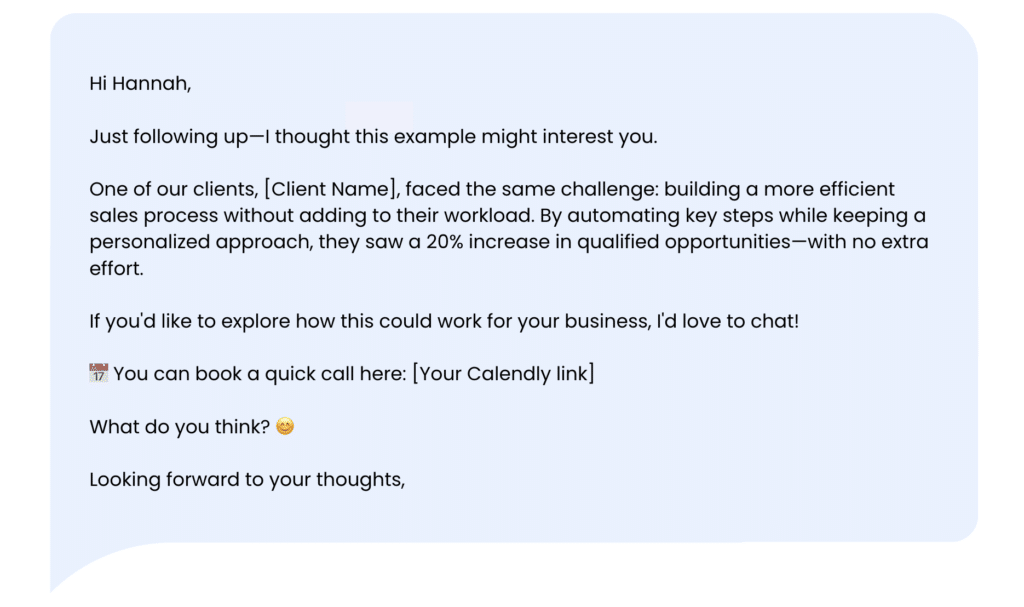
6. Closing the sale : Turn prospect into customer
You’ve qualified your prospect, he’s understood the value of your solution, and he’s received your proposal. Now it’s time to take action. This is the closing stage ✨
But, closer, what does that mean exactly?🧐
We often think that closing = getting a contract signed, but in reality, it depends on your objectives and your sales strategy.
- If you’re selling subscription software, it might be converting a prospect into a free trial user. 🤩
- If you’re in the consulting business, it could be getting them to book an initial paid call. ☎️
- If you’re in B2B sales with long cycle stages, it could be moving the prospect on to the next stage of negotiation. 🤝
So closing isn’t always an immediate sale, but it’s always a concrete action that brings your prospect closer to the final purchase. 😎
7. Follow-up and loyalty: what happens after the purchase?
Congratulations, you’ve reached the final stage – you’ve done the hard part! Now there’s just one step left in your sales cycle: Keeping your customers! 🥳
Keeping a customer costs much less than acquiring a new one, and a satisfied customer can become a true ambassador for your brand.😍
This step is often underestimated, even though it enables you to increase your customer retention, generate referrals and create a real relationship of trust-essential for every sale.
➡️ Good customer follow-up helps you :
- ✅ Improve customer experience and satisfaction.
- ✅ Create a strong bond and encourage loyalty.
- ✅ Turn your customers into ambassadors who will spread the word.
But how do you do it? 😥
1. Set up a GOOD onboarding
The first contact after the purchase is essential: you mustn’t leave your new customer on their own, as they may not know how to use your solution to the full. To avoid this:
- Send a personalized welcome email with the first steps to follow. 📨
- Offer a customer onboarding directly on the tool,or training to help them get to grips with the tool. 👩🏻🏫
- Set up customer support. 📞
To simplify the task, you can use tools like Mailchimp to automate the sending of welcome and follow-up emails. 😴
2. Maintain engagement with lead nurturing
An active, engaged customer is more likely to remain loyal. To achieve this, you need to deliver value on a regular basis, even after the sale. That’s where lead nurturing comes in. Here are some content ideas 👇🏻 :
- The check-in email after 7 days to find out how the early days are going. 💌
- Tips and best practices to get the most out of your tool. 🎯
- New and updated features for your tool. 📝
- Educational, share case studies, organize webinars or run a blog. 🎓
3. Get customer reviews and recommendations
A happy customer can become your best salesperson! But to do that, they need to talk about you. And to do that, you need to encourage your satisfied customers to share it! To do this, visit 👇🏻 :
- Send them an e-mail after a few weeks’ use, asking them to share their opinion 📮
- Highlight positive reviews on your social networks or website. ⭐️
- Create an ambassador program to reward customers who recommend your solution the most (bonus, preview, discounts…).💰
4. Anticipate to avoid churn
A high churn rate is not good for your business, but you can easily spot the signs of departure 🥲 :
- He no longer uses your product or his activity decreases.😒
- He no longer replies to your emails or consults your content.😔
- He expresses problems or asks questions about cancellation.😱
In this case, there are several solutions. You can send personalized reminder emails, suggest appointments or offer a suitable solution such as a change of offer. 🤓
How to improve your sales cycle?
A well-structured sales cycle is all very well. But if it’s not optimized, you risk losing prospects along the way! Too many steps, poorly targeted follow-ups, a lack of fluidity between marketing and sales… All these elements can slow down your process and cause your conversion rate to plummet. Here’s how to boost your sales cycle! 🌟
Map your sales cycle to detect blockages
Before you can optimize anything, you need to understand where things get stuck. Is your message clear? Is the user experience smooth? At what point do your prospects give up?🧐
To find out, you can visualize your sales cycle step by step, and pinpoint friction points. It could be a form that’s too long, a poorly optimized page, a lack of follow-up… In short, little details that make all the difference! 😌
A great tool for this? Heatmaps like Hotjar. These tools show you where visitors click, where they hesitate and, most importantly, where they leave your site. For example, if half your prospects abandon a form before validating it, there may be too many fields to fill in 🫠
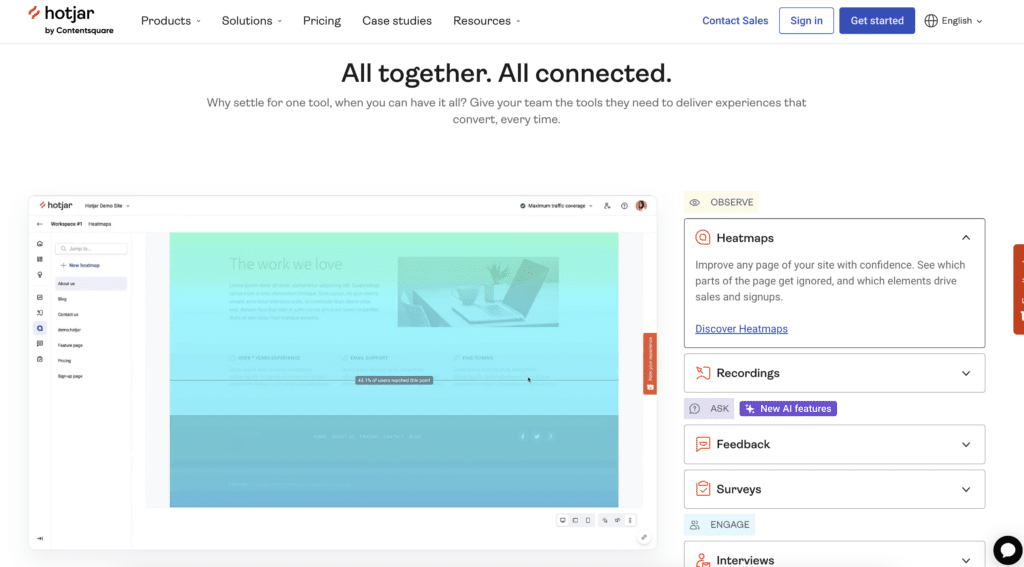
Align marketing and sales to avoid lost leads
A classic problem in many companies: marketing attracts prospects, but sales can’t convert them. Why is this? Because the leads aren’t always properly qualified, or the transition between acquisition and conversion is poorly managed 😣
To avoid this problem, you need to make sure everyone is working hand in hand.🤝
- Marketing: Generate leads with relevant content and well-targeted campaigns.
- Sales: Take over with the right message and effective follow-up.
A good way to do this is to use a TAGS system. With a tool like Waalaxy, you can find out what each prospect has validated (clicks, downloads, responses…) and then organize them. 🧠
Set up an SLA (Service Level Agreement) between marketing and sales. This is an agreement that defines, for example, how many qualified leads marketing should send to sales each month. The result? Less frustration, more efficiency!
Track the right KPIs to improve your performance
If you don’t track your results, it’s impossible to know what‘s working and what needs adjusting.
Here are the indicators to keep an eye on 👇🏻 :
- ⭐️ Conversion rate: How many leads actually go on to purchase?
- 📨 E mail open rate : How effective are your emails and messages?
- ⏱️ Sales cycle time: Too long = loss of leads along the way.
- 🛒 Abandonment rate by stage: At what point do prospects give up?
To take things a step further, try out different approaches withA/B testing. For example, test two versions of a follow-up email to see which generates more responses. You can do the same with your sales pages, your sales pitches… Little by little, you’ll refine your strategy. 😏
Automate certain tasks to save time
Rather than repeating the same actions over and over again, automate what can be automated! 😎
Automate your LinkedIn and email prospecting with Waalaxy
Sending invitations manually, writing each message one by one… it’s inefficient and time-consuming. Waalaxy lets you prospect automatically on LinkedIn and by email with intelligent sequences.🤓
- You define a scenario: invitation + personalized message + automatic follow-ups. 📨
- You combine LinkedIn and email to maximize the chances of response.
- You track performance (click-through rates, open rates, responses) to adjust your approach.
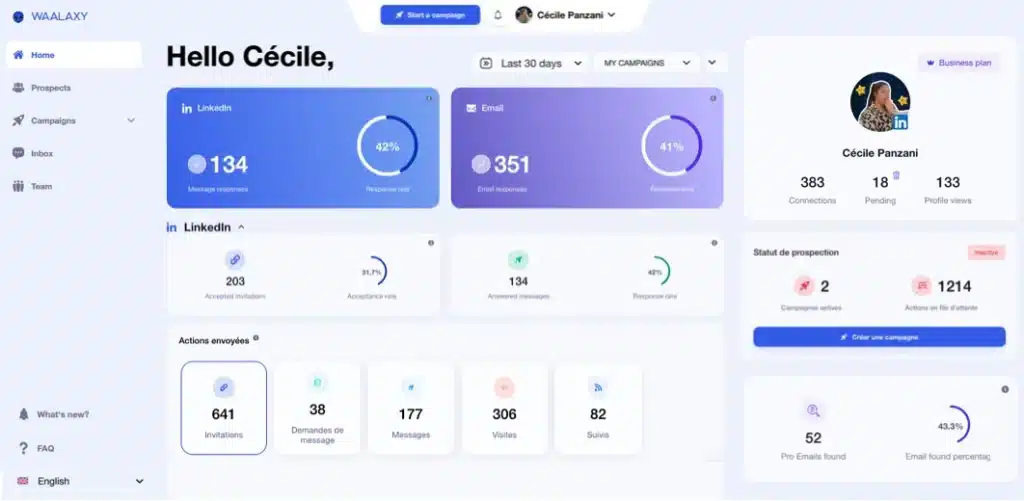
Qualify your leads better with automatic scoring
Lead scoring is based on a system of points awarded to each prospect according to their actions. The more interest they show, the more points they accumulate and become a priority.
- 📩 Interactions with your emails : Did they open your messages? Clicked on a link? Replied?
- 🔗 Engagement on LinkedIn: Did he accept your connection request? Reacted to your message?
- 🌍 Visits to your site: Did he visit several pages? Did he spend time on the pricing page?
- 📅 Booking an appointment: Did he book a discovery call via Calendly?
- ⏳ Exchange history: Has he ever talked to you about a specific need?
Each action awards a certain number of points to the lead. The more points it accumulates, the higher its priority. For example 👇🏻 :
- +10 points: Open an email.
- +20 points : Clicking on a link.
- +30 points: Replying to a message.
- +50 points: Request an appointment.
A lead with more than 50 points is considered warm 🥵 below 20 points, it’s still lukewarm.
Simplify appointment setting
When a prospect is interested, don’t waste time on endless email exchanges. With Calendly, you send them a link, and they book an available slot themselves 📆
✅ Less back and forth, more efficiency.
✅ Automatic reminders to avoid forgotten appointments.
✅ A smooth, professional experience.
Winning combo: Waalaxy for prospecting + Calendly for easily booking appointments. ⭐️
How about a recap of the stages in the sales cycle?
A good product is not enough to guarantee sales success. It’s how you support your prospects throughout the sales cycle that makes the difference. If your process is smooth and well-structured, you maximize your chances of conversion and close more deals while avoiding unnecessary losses.
📌 An effective sales funnel includes:
✅ Well-targeted prospecting to attract the right leads.
✅ An engaging first contact that captures attention.
✅ Precise qualification to prioritize the hottest prospects.
✅ A punchy presentation that addresses the customer’s needs.
✅ A clear sales proposal.
✅ An effective closing that makes it easy to close more deals.
✅ Customer follow-up that turns your buyers into ambassadors.
And to go even further, automation is your best ally. With tools like Waalaxy or Calendly, you can simplify your prospecting, qualify your potential customers more quickly, and follow up effectively and effortlessly—paving the way for sales success. ✨
Frequently asked questions
What’s the difference between a B2B and B2C sales cycle?
The sales cycle is the process that transforms a prospect into a customer. Whether B2B or B2C, the objective remains the same: to convert a potential buyer into a loyal customer. But there are a few differences 👇🏻 :
| B2B | B2C |
|---|
| Number of contacts | Several (decision-makers, buyers, users) | Usually just one person |
| Decision-making time | Long (weeks to months, or even longer) | Short (seconds to days) |
| Purchasing process | Structured, requires internal validation | Simple, often based on emotion |
| Transaction amount | Higher, requires negotiation and contracts | Lower, standardized purchase |
| Marketing’s role | Educate, demonstrate value and ROI | Attract, seduce and trigger immediate purchase |
| Offer complexity | Tailored to specific needs | More standardized |
| Conversion mode | Demonstrations, sales calls, negotiations | ADS, website, influencers, points of sale |
How to train your sales team for an efficient sales cycle?
A well-trained sales team means more deals signed and a smoother sales cycle management. But beyond skills, a sales manager plays a key role in keeping the team motivated and performing. Here are three essential levers to improve your sales and drive successful sales 🚀.
- Master the offer and refine the pitch:
A salesperson who knows their product and market inside out is more convincing and at ease when dealing with prospects. They must know how to respond to objections, understand the customer’s needs, and adapt their sales pitch to close the deal. 📝
You can offer regular training courses on the product and sales techniques, as well as role-playing games to practice objections and negotiations. This will help create a clear sales pitch that emphasizes value rather than features. 🤗
- Equip yourself with the right tools:
Managing your pipeline manually is a thing of the past! The right tools save time and prevent missed leads, ensuring successful sales. Here are my must-haves:
- 🛠 A CRM to track prospects and follow up at the right time.
- 🤖 Waalaxy to automate LinkedIn and email prospecting.
- ⭐️ Mailchimp for tracking your emailing.
- 📅 Calendly to avoid round-trips and book appointments in one click.
- Smart management to keep your team on top:
Good team management means setting ambitious but achievable goals and maintaining a good group dynamic. A motivated team means more commitment and more sales.
The right pratiques👇🏻:
- 🎯 Create challenges to stimulate the desire to improve your sales.
- 🔥 Monitor performance without excessive pressure.
- 🏆 Reward success with motivating bonuses or benefits.
Now, the sales cycle has no secrets for you! 🚀


